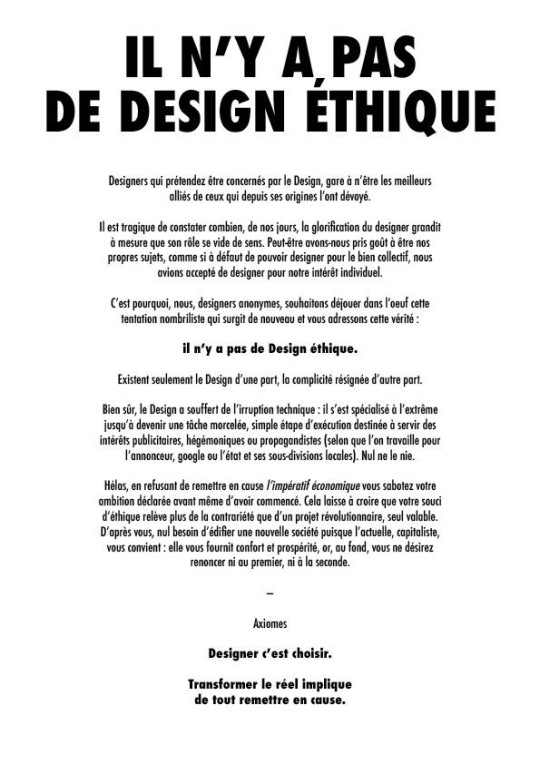Photo





(via Play.ht | Convert your Medium stories to audio)
Make your Medium stories listenable as podcastsIncrease content accessiblity, user engagement and time on page metrics using 100+ realistic AI voices.ADD TO CHROME FOR FREE
0 notes
Link

https://blog.touchedeclavier.com/la-bonne-posture-a-adopter-devant-son-ordinateur/

https://www.mayoclinic.org/healthy-lifestyle/adult-health/in-depth/office-ergonomics/art-20046169
The most important is to move your body regularly. Try this alternative posture.
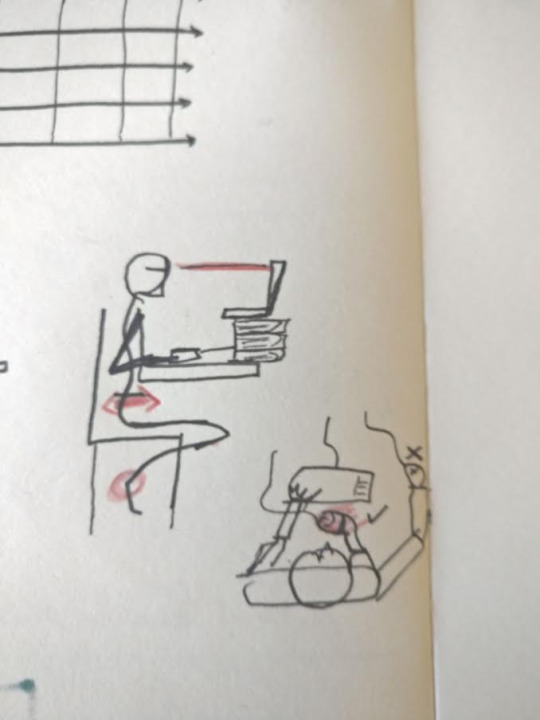
https://blog.touchedeclavier.com/la-bonne-posture-a-adopter-devant-son-ordinateur/
0 notes
Video
youtube
voir aussihttps://www.youtube.com/watch?v=LwjE_N-eG68https://tedxclermont.fr/speaker/dominique-bourg/
0 notes
Link
0 notes
Photo

(via Project · 4Cs - From Conflict to Conviviality through Creativity and Culture)
4Cs: From Conflict to Conviviality through Creativity and Culture is a European Cooperation Project co-funded by the Creative Europe Programme of the European Union. The 4Cs seeks to understand how training and education in art and culture can constitute powerful resources to address the issue of conflict as well as to envision creative ways in which to deal with conflictual phenomena, while contributing to audience development through active participation and co-production. The project aims at advancing the conceptual framework of intercultural dialogue and enhancing the role of public arts and cultural institutions in fostering togetherness through cultural diversity and intercultural encounters.
The European Commission has acknowledged that tackling the migration and refugee crisis is a European obligation that requires a comprehensive strategy and a determined effort. Within such framework, the European Commission has emphasised the role of culture and the arts in contributing towards building a more cohesive and open society through the integration of refugees, helping them to better understand their new environment and its interaction with their own socio-cultural background.
Grounded in the belief that culture and creative practice can emerge as powerful resources in conflict situations, the 4Cs wishes to respond to this challenge by exploring the ways in which culture and the arts can help bring individuals together within a model of intercultural dialogue, mutual recognition, and equal participation. This will be achieved by fostering equal involvement and by promoting cross-cultural collaboration through the creation and development of different activities such as exhibitions, artistic and research residencies, film screenings, mediation labs, workshops, conferences, publications, an online platform, and a Summer School.
The 4Cs aims at responding to the challenges of migration, security, and freedom of expression by raising awareness about the role of creative and cultural work in the strengthening of European identity and European citizenship in a project of peace and conviviality. The 4Cs will support community members in their role as active agents in the cultural scene at local, regional, national, and international levels and contribute to a lasting change of attitude and active citizenship in local communities.
0 notes
Video
Friends killing time, making art and nailing it…
vimeo
*Automata Farm
18 notes
·
View notes
Text
Explaining design for policy making to an oncle. Check √
Salut XXX,
Suite à notre discussion sur ces nouvelles pratiques des designer qui visent à assister les mairies (par ex.) dans leur travail pour être davantage collaboratives avec leurs administrés, voici quelques références.
L'agence de “design des politiques publiques” (on appelle ça comme ça) en drôme-ardeche dont je te parlais a fait un film pour montrer un de leur projet. Le voici : https://vimeo.com/160865689
Ici tu trouveras un site qui explique un peu le contexte : https://leteilgaribaldi.wordpress.com/le-projet/
Ici, le site de cette agence qui s'appelle “De l'aire”: http://www.delaire.eu/accueil
Voici enfin le site d'une conférence à laquelle j'avais assisté et découvert l'agence De l'aire. C'était une conférence sur ces nouvelles pratiques de design. https://despoliti.hypotheses.org/les-intervenants On y trouve notamment cette autre agence qui est à Marseille http://loffice.coop/accueil/qui-sommes-nous/ et cette agence (qui est la plus connue) http://www.la27eregion.fr/ et celle-ci plus récente, avec qui je travail de temps à autres http://vraimentvraiment.fr
C'est tout pour aujourd'hui,
Bise !
Max



0 notes
Photo
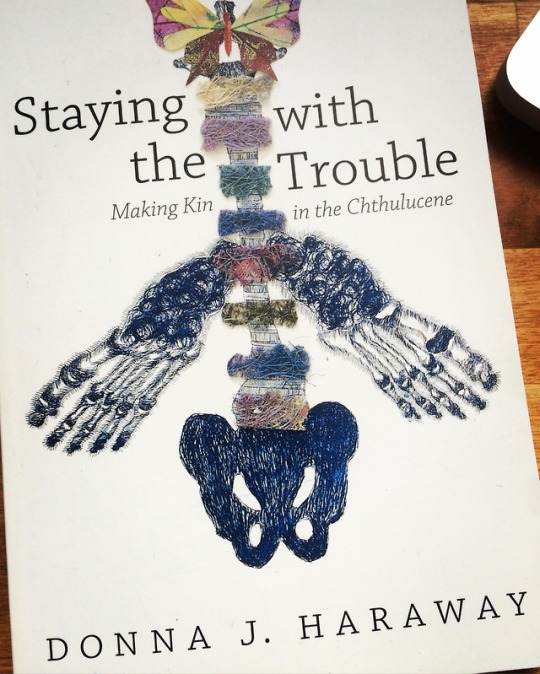
(via Book Review: Donna Haraway’s Staying with the Trouble – The Chart)
“Think we must! We must think!”
— Stengers and Despret, Women Who Make a Fuss1
It has never been clearer than now that we must “stay with the trouble” and actively seek possibilities for recuperation even as we are anxiously learning the great depths of the trouble we face. This is a book concerned with exactly that, with teasing out effective methodologies for moving forward in contemporary times through invention, collaboration, exploration, play, and a willingness to take on the risky business of “follow[ing] the threads where they lead.”2
Donna Haraway, radical thinker of A Cyborg Manifesto fame3, envisions the Anthropocene — along with its aptly named partners the Capitalocene4 and the Plantationocene5 — as a (brief) geologic boundary event, and encourages us to think of a bigger name encompassing all “the dynamic ongoing sym-chthonic forces and powers of which people are a part, within which ongoingness is at stake”.6 She terms this era the Chthulucene. Having nothing to do with Lovecraft’s “misogynist racial, nightmare monster” Chtulu, this Chthulucene (note spelling) is an era of multi-species worlding and “sym-poietic” thinking and making together. Anthropologist, multispecies feminist theorist, environmentalist, and distinguished professor emerita in the History of Consciousness department at the University of California, Santa Cruz, Haraway proffers the action of reaching out and “making kin” as a way to establish new lines of “response-ability” between living beings. She draws actively on new thinking in the sciences and arts to present possible methodologies for inhabiting our world at present.
Already, you’ll see I’ve run through a handful of knotty neologisms; Haraway delights in language, bumping colloquialisms against high theory, breeding slang with scientific taxonomy — part of the pleasure of reading this text is her “bumptious” linguistic methodology: experimental, creative, rich, chewy, and rhythmically vital — thinking new worlds demands thinking new language. If you’re like me, you’ll want to follow and participate in these new inventions as you enter and occupy this terran text. Using the tools of what she terms “SF” — speculative fabulation, speculative feminism, science fiction, science fact, string figures, so far — Haraway imagines and invents new ways of “living and dying” in our multispecies world. Messy and imperfect, and actively generative, this co-fashioning methodology invites new perspectives on the depths of our connections to each other, our notions of independence, and the inseparable threads we must follow and affirm in perilous times.
Haraway delights in language, bumping colloquialisms against high theory, breeding slang with scientific taxonomy — part of the pleasure of reading this text is her “bumptious” linguistic methodology: experimental, creative, rich, chewy and rhythmically vital — thinking new worlds demands thinking new language.
For we are utterly and hopelessly entangled in this story. The first chapter looks at multispecies storytelling through the lens of string figures as metaphor and engaged games of giving and receiving, and at practices of recuperation via the possibilities of making something together (“sympoiesis”). String figures — the games of making patterns with loops of string between players — enact a rich history of storytelling through physical thinking enacted between two people. Haraway recognizes the complexities of this tool and the possibilities of failure — of dropping a thread, of getting caught in a story that doesn’t function — in the “risky comaking” practices of SF. Deeply challenging our ideas of individuality, the Chthulucene demands we engage sympoiesis, making together, rather than autopoiesis, self-making. Throughout the book, she investigates the work of interdisciplinary artists and scientists who are inventing new ways of working together and with other species, and who are developing new sensitivities and means to fostering collective response-ability.
For example, Haraway introduces her reader to PigeonBlog, the work of artist Beatriz da Costa, her students, and the racing pigeons that flew as part of a Seminar in Experimental Critical Theory at the University of California Irvine and in electronic arts festivals in San Jose, California. Homing pigeons, with their fanciers, artists, and engineers, were engaged to “collect and distribute information about air quality conditions to the general public.”7 Through the informed, careful, and pigeon-loving practices of their fanciers and interested others, a small data collection backpack was created for the pigeons that allowed the gathering of data in order to generate “further imaginative and knowing action” in multiple disciplines and beings. Da Costa “took seriously questions about the cosmopolitics and material-semiotics of collaboration for animals in art, politics, or science. Who renders whom capable of what, and at what price, borne by whom? But she asked ‘Is human-animal work as part of political [and art] action less legitimate than the same type of activity when framed under the umbrella of science?'”8 The project made visible the limited government collection data that focused its attention away from known pollution sources and thus pollution levels, often in working-class communities, near to the ground at the level where humans and other species live and breath.
In a later chapter, Haraway investigates the utter entanglement and disturbing truths regarding both the need of and the production methods for DES and Premarin: hormones for the changing female animal body, human and other “critters”. DES, now a known poisonous synthesized cancer-producing hormone marked unsafe for humankind is prescribed for her aging companion dog. And Premarin, a hormone she once took, is produced by the labor of countless pregnant mares (don’t ask what happens to the foals) via the “animal-industrial complex” and currently relied on by many menopausal women to ease the difficult passage through declining levels of estrogen. In each case, Haraway’s investigation navigates the webbed network of relationships between humans and other “critters” and refuses to turn away from the troubling implications, positive opportunities, and seeming infinite intersections infecting multiple beings. This lack of innocence might inspire new means to multispecies recuperation, she says. “Call that utopia; call that inhabiting the despised places; call that touch; call that the rapidly mutating virus of hope; or call that the less rapidly changing commitment to staying with the trouble.”9
In the times of “The Dithering,”10 this is a call to arms: the many tentacular arms of the octopus and spider, the chthonic sea creatures, and the webbed, interconnecting rhizomic roots of mycelium. The Chthonic beings of the Chthulucene are beings of the Earth whose living and dying are all very much “at stake” together. “Coral and lichen symbionts11 also bring us richly into the storied tissues of the thickly present Chthulucene, where it remains possible — just barely — to play a much better SF game, in nonarrogant collaboration with all those in the muddle,”12 she notes. This collaboration demands we join forces and make kin in order to rejuvenate refuges that allow species continuance and possible flourishing. Haraway draws on the “science art worldings” of new Inupiat story making practices, Navajo weaving at Black Mesa, Arizona, and the Crochet Coral Reef project coordinated by the Institute for Figuring, among others, to seek new models for staying with the trouble and recuperating spaces of refuge. Her call to “Make kin, not babies!” is a call to extend the web of connections beyond those ties of ancestry or genealogy in order to invoke and practice a deep responsibility to many others; she reminds us, “all earthlings are kin in the deepest sense.”13
Haraway’s investigation navigates the webbed network of relationships between humans and other “critters” and refuses to turn away from the troubling implications, positive opportunities, and seeming infinite intersections infecting multiple beings.
“What happens when human exceptionalism and the utilitarian individualism of classical political economics become unthinkable in the best sciences across the disciplines and interdisciplines? Seriously unthinkable: not available to think with.”14 Throughout the book, Haraway urges us to think. Referring to the work of social anthropologist Marilyn Strathern she notes, “it matters what ideas we use to think other ideas with.”15 We need new ideas and new ways of thinking, new kinds of stories to think with, because the old ones are failing us as is evidenced not only by the inequities and mania of our resource extracting current economies, the Great Acceleration, and radically increasing human population numbers16, but also made visible within the day-to-day laboratory models of contemporary scientific practices that no longer sufficiently address contemporary conditions. Haraway affirms that speculative fabulation, speculative feminism, and science fiction help us think anew.
The final section of Staying With the Trouble entails a work of feminist speculative fiction, created together with filmmaker Fabrizio Terranova and science philosopher Vinciane Despret, concerning a human-butterfly symbiont. The task entertained by the text is to think ahead five generations, something you immediately sense the gravity of as our predicted event horizons for ice-cap melting, sea-level rise, and species extinctions continue to shrink. In this work, SF inventions are woven into the fabric of a story that imagines our reality based from within current knowledge and experience, culling potential from our current stories to create new ones in stark contrast to the excesses of neo-colonial resource extraction methodologies on a shrinking planet. Cobbled together, and eschewing notions of easy futurist saviors or various head-in-the-sand technofixes — “we cannot denounce the world in the name of an ideal world”17 — Haraway’s inventions take a functional, sited, materialist viewpoint on future possibilities based on working intently with the present moment.
We need new ideas and new ways of thinking, new kinds of stories to think with, because the old ones are failing us.
This is a book that focuses on processes, on possibilities, and on methodology as a commitment to “ongoingness”. It also focuses on situated imaginative revisions to working within the present: staying with the trouble. Outcomes are unknowable; the story is not yet written. This is praxis: engaged “tentacular” thinking; working together with an understanding that it is all unwritten. Embracing our collective conditional futures — our multi-species futures — and thinking together towards something that seeks possibilities for recuperation and rejuvenation, a process of living and dying together in a deeply stressed system evidencing massive extinction events and cascading systemic environmental break downs — is of utmost urgency. This is a text that embraces presence and alert attention to this moment — sticking it out in the here and now to trouble the waters of entrenched capitalist models that collectively contribute to ongoing destruction of the very systems that sustain us in all their rich and challenging complexity.
Inspiring, to say the least. And we are in deep need of it.
Staying with the Trouble: Making Kin in the Chthulucene, by Donna J Haraway. Duke University Press, 2016, 296 pages, paper, $26.95, ISBN# 978-0-8223-6224-1
Used throughout the book, via Isabelle Stengers and Vinciane Despret (Women Who Make a Fuss), via Virginia Woolf (Three Guineas) and through Maria Puig de la Bellasca, (“Politiques féministes et construction des savories)
Staying With the Trouble, pg 3
https://en.wikipedia.org/wiki/A_Cyborg_Manifesto
Some feel it is more apt to call our era the Capitalocene rather than the Anthropocene, calling into attention an “historical era shaped by relations privileging the endless accumulation of capital.” (John Merrick, http://www.versobooks.com/blogs/2360-jason-w-moore-anthropocene-or-capitalocene)
A term for the “devastating transformation of diverse kinds of human-tended farms, pastures, and forests into extractive and enclosed plantations, relying on slave labor and other forms of exploited, alienated, and usually spatially transported labor.” Scott Gilbert, https://studylib.net/doc/13485101/anthropocene–capitalocene–plantationocene–chthulucene-…
Staying With the Trouble, pg 101
Donna Haraway, Staying with the Trouble; Making Kin in the Chthulucene(Durham and London: Duke University Press, 2016), 21.
Haraway, Trouble, 23.
Haraway, Trouble, 114.
Haraway, Trouble, 102. A term introduced by Kim Stanley Robinson in his book, 2312 in 2012.
symbiotic interpenetrating ecological assemblages
Haraway, Trouble, 56.
Haraway, Trouble, 103.
Haraway, Trouble, 57.
Haraway, Trouble, 12.
Human population (currently 7.3 billion) predicted to reach 9.7 billion by 2050, and 11.2 billion by 2100 by the United Nations Department of Economic and Social Affairs in 2015. http://www.un.org/en/development/desa/news/population/2015-report.html
Haraway, Trouble, 12.
0 notes
Link
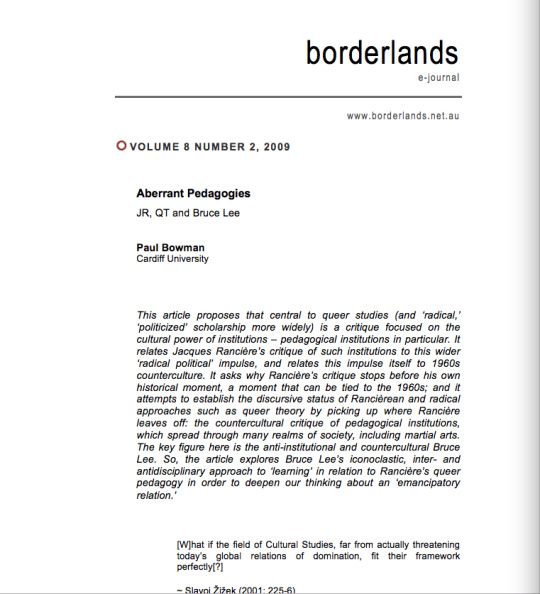
Bruce Lee is hard. Bruce Lee is sexy. Bruce Lee is cool. Bruce Lee is not white. Bruce Lee is Asian. Bruce Lee kicks white, American, Russian, Japanese, Italian, imperialist, colonialist, capitalist, gangster and indeed anyone and everyone’s ass. There is something patriarchal here, in this phallic hero. There is also something homoerotic. There is something heteronormative. There is also something postcolonial. This much we know. But is that it? Is that all there is? Within film studies, cultural studies, postcolonial studies and various ethnic identity studies, this appears to be about the long and short of it. These are the main sorts of lessons that are regularly learned from and about Bruce Lee: lessons about identification, lack and desire, about cultural identity, the role of fantasy, about the body as bearer of ideology, the ambivalence and polysemy of Bruce Lee’s texts, the homo at the heart of the hetero, and so on (Abbas, 1997; Brown, 1997; Chan, 2000; Eperjesi, 2004; Hunt, 2003; Marchetti, 2001; Morris, 2001; Teo, 2008). These are important lessons. But there is more. There are other lessons to be learned from Bruce Lee, no less queer than those readings which try to queer Bruce Lee, or those that fantasize through him, with him, in him, of him. These lessons are not necessarily or literally sexual, but they are wedded or welded to patriarchal, arboreal and phallogocentric structures.
The ones I would like to draw attention to here relate to learning, to lessons that have been learned, and to the significance of the ways in which the lessons that are to be learned from Bruce Lee intersect unexpectedly with lessons in and about the ‘project’ of cultural studies and its critics. In saying this, I am using the term ‘cultural studies’ as short-hand, as an umbrella term to evoke the genealogically and ethico-politically entangled discursive formation of work in postcolonialism, history from below, gender studies, poststructuralism, queer theory and – as is so easy to say – so on. My decision to elevate ‘cultural studies’ as the umbrella term to cover such a wide, complex and contradictory field will, I hope, neither be received as particularly controversial nor as especially unusual, as each of these overlapping fields always also folds into the others and has them folded into ‘itself’ in more than one way.[1]
0 notes
Link
(via Who the Fuck is Jacques Ranciere? | Critical-Theory.com)
WHO THE FUCK IS JACQUES RANCIERE?
A French critical theorist and philosophical troll in a world of ivory tower intellectualism, bourgeois academics, and Jean Baudrillard, Ranciere stands out as a kind of anti-philosopher. A University of Paris professor and former student of Louis Althusser, Ranciere has committed his intellectual project to destroying its foundations.
While that may sound a lot like Baudrillard, who wants to remind everyone that everything is simulation and nothing matters, or Nietzsche who attacks the foundations of Western metaphysics, Ranciere takes a different approach. Namely, by accusing every other philosopher of being a shitty Platonist and hating democracy.
While other philosophers deconstruct the metaphysical tradition and replace it with their own project, Ranciere’s philosophy can be summed up by “meh, people will figure it out.” And thus we present: the thought of Jacques Ranciere.
#1 “Fuck the Police” is Pretty Much his Definition of Politics

This counts.
In his “Ten Theses on Politics”, Ranciere makes a simple claim. There are two kinds of politics in the status quo, fake poser bullshit masquerading as politics and the real thing. Ranciere calls the poser politics the “politics of the police”. Ranciere calls “real” politics “dissensus.”
What the Fuck is Dissensus?
Dissensus is the process by which actors disrupt the politics of the police.
You see, the police are all about telling you what to do and where to do it. Remember that time that cop got all up in your grill for skateboarding in front of 7-11? Or, if you’re a person of color, remember that time a cop arrested you and planted drugs on you for skateboarding in front of 7-11? That’s the police order; the partitions that the police put in place for what can be seen, said and done, and where they can be done. When that cop drove away and you kept skateboarding, you totally disrupted the police partitioning of that space (sort of).
The police says that there is nothing to see on a road, that there is nothing to do but move along. It asserts that the space of circulating is nothing other than the space of circulation. Politics, in contrast, consists in transforming this space of ‘moving-along’ into a space for the appearance of a subject: i.e., the people, the workers, the citizens: It consists in refiguring the space, of what there is to do there, what is to be seen or named therein. It is the established litigation of the perceptible. – Ten Theses on Politics
We can see how these police partitions work in the events of Occupy Wall Street.
You see, some bankers made this park on stolen native land for them to eat lunch in while they rested from robbing the world of millions of dollars with complicated derivatives and other bullshit nobody understands. When some hipsters decided they wanted to camp out on Wall Street, the police were like “GTFO bro”. And when those hipsters started camping out in Zuccoti Park and ruining those bankers lunches, the police calmly reminded the protesters that the park belonged to white people in suits. The police reminded the protesters that if they want to take part in this “politics” business they need to vote like everyone else, or at least have some sort of “concrete demands”. But they didn’t, so then they started pepper spraying kids.
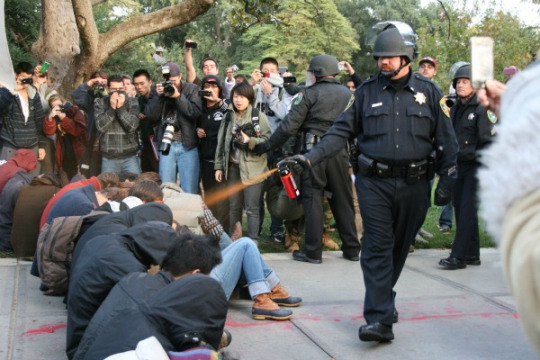
That’s what the police order does, it tells you to take part in the fake politics – casting a ballot, going to a town hall – and tries to divest energy from what Ranciere calls real politics. After all, the Egyptian revolution didn’t start because people started sending nicely worded petitions to the government. It started when people manifested themselves in the public spaces that were once apolitical.
#2 He Doesn’t Get Along with his Colleagues
Ranciere got his first exposure by contributing to Reading Capital with his teacher Louis Althusser.
//////
https://www.wikiwand.com/fr/Lire_le_Capital
Dialectical materialism is a philosophy of science and nature developed in Europe and based on the writings of Karl Marx and Friedrich Engels. In contrast to the Hegelian dialectic, which emphasized the idealist observation that human experience is dependent on the mind's perceptions, Marxist dialectics emphasizes the importance of real world conditions, in terms of class, labor, and socioeconomic interactions.
-
Historical materialism, also known as the materialist conception of history, is a methodology used by some communist and Marxist historiographers that focuses on human societies and their development through history, arguing that history is the result of material conditions rather than ideas. This was first articulated by Karl Marx (1818–1883) as the "materialist conception of history." I
///////
It may be surprising that a few years later Ranciere put out Althusser’s Lesson which might have well been a raging “fuck off” to his teacher and mentor. The quarrel started over the events of May ’68. While Althusser and other Marxists were asserting the importance of Marxist academia in the French student revolts, Ranciere began to break away from this traditional mode of thought. Marxist intellectuals accused the revolts of being bourgeois and undisciplined. To which Ranciere accused Marxists of being a bunch of little shits:
The underlying idea, to focus solely on the theoretical level, is not only that Marxism is learned exclusively through books, but also that it is learned only from the classics. It is that every development is a betrayal, that every application of Marxism is a deviation into pragmatism, ideology, and political manipulation. We can see quite clearly from the phrase, ‘to focus solely on the theoretical level’, that what was at stake on the practical level was the rejection of the ‘developments’ that Khrushchev, with his successors and emulators, had introduced to ‘classical’ Marxism. This was the time, for example, when it was common to teach that peaceful coexistence was the supreme form of class struggle . . . The purism of theory could not but have political effects. And that was really all that mattered: we could say everything, provided nothing that we said had practical effects. – Althusser’s Lesson
But that was just the start. Ranciere’s project became more and more defined as time went on. From a criticism of Althusser and orthodox Marxism, Ranciere’s message soon became “Philosophy – it’s a big bag of dicks.” Writing Hatred of Democracy, Ranciere attacks the Platonic tradition and ties it to practically every Marxist philosopher. He argues that everyone in the Western tradition, from Plato to Marx, wants to become a philosopher king to shovel Truth into the mouths of the blind ignorant masses. Ranciere carries this line of thought to his other books such as “Disagreement” where he accuses every theorists of democracy of being a Platonic saboteur.
One of his most famous feuds is with fellow Althusser alumn Alain Badiou for his self-professed Platonism.
Badiou, whose goal is to revive an “egalitarian Platonism,” penned an essay about Ranciere titled “The Lessons of Jacques Ranciere: Knowledge and Power After the Storm,” whereby Badiou acknowledges that the shittiest thing he could ever to do Ranciere is agree with him:
“To speak only well of Jacques Ranciere is not an easy task, given the positions that the two of us occupy. Perhaps my constant praise might, in fact, be the worst fate that I could have in store for him. Would doing so be precisely the most underhanded way to attack him? If, for example, I were to announce that we are in agreement on a number of important points, how would he take that? Would he rather just as soon change his mind on all those points and leave me behind?” – Jacques Ranciere: History, Politics, Aesthetics
And then there’s Jean Baudrillard. Baudrillard, who started his career by telling everybody to “Forget Foucault” is an academic troll par excellence. The theorists of simulation has taken Guy Debord’s Society of the Spectacle and turned it into a nihilistic portrait of doom and despair. But Ranciere ain’t got time for that. Writing in “The Misadventures of Critical Thought” he says “theorists of simulation” (a not-so-subtle reference to Baudrillard) are at the heart of simulation itself.
The Marxism of the denunciation of the mythologies of the commodity, the fallacies of consumer’s society and the empire of the spectacle. Forty years ago, it was supposed to unmask the machineries of domination, in order to provide the anti-capitalist fighters with new weapons. It has turned to exactly the contrary: a form of nihilist knowledge of the reign of the commodity and the spectacle, of the equivalence of anything with anything and of anything with its image
…The current disconnection between the critical procedures and any perspective of emancipation only reveals the disjunction at the heart of the critical paradigm. It may make fun of its illusions but it remains enclosed in its logic. This is why I think it is necessary to re-examine the genealogy of the concepts and procedures of that logic and the way in which it got intertwined with the logic of social emancipation.
– The Misadventures of Critical Thought
#3 He Thinks Your Professor is Worthless
It might seem ironic for a teacher to conclude “fuck smart people.” But in The Ignorant Schoolmaster, Ranciere makes that very claim. You see, Ranciere has been hating on philosophers from the very beginning. From his very start in Althusser’s Lesson, to Hatred of Democracy, to The Philosopher and his Poor, Ranciere is constantly accusing philosophers of proposing a capital T truth to reign down in a golden shower of truth onto ignorant masses. That makes a really compelling case for why I shouldn’t be reading Ranciere at all, and maybe just fucking up the police on my own terms.
But in The Ignorant Schoolmaster, Ranciere takes teachers to task. You see, teachers are trying to make you stupid. Really stupid. Like you would be better off thinking about shit really hard instead of taking a class on something. Why does he say that?
There was this dude named Jacotot, and he was awesome. He was a French guy who went to teach in Belgium after the French Revolution. He was teaching French, but his students only spoke Flemish. He, by the way, did not speak Flemish. So doing what any responsible teacher would do, Jacotot gave them a recent version of this book Telamaque that had the French on one side of the page and the Flemish on the other side and said “figure it out.”
And they did.
Ranciere advocates this form of “universal education” and says the traditional teacher/student model is only meant to perpetuate societal inequality and keep students in a state of stultification. Stultification – that’s a fancy word for stupid. The implications of this philosophy are A) You don’t need a teacher like Ranciere to teach you anything and B) An illiterate parent could teach their children to read by plopping a book down and saying “figure it out.”
The crazy part? This shit works, and not just around random corners of Europe where the tradition was born.
You know how your dumb ass can barely figure out how to change the settings on your Kindle? Remember that fancy college degree you spent more than $100k on? Well fuck you, because kids in Ethiopa who don’t even know what a tablet is can not only fix your settings but remove any pesky security measures while they’re at it.
You see, someone at One Laptop Per Child had the bright idea of just dumping a bunch of Motorola Zoom tablets in an Ethiopan village full of kids. The children did not speak English, which was the language loaded on the tablet, and they had never seen a computer before. Within weeks these kids were fucking wizards with the things so much so that they actually figured out how to jailbreak them.
“We left the boxes in the village. Closed. Taped shut. No instruction, no human being. I thought, the kids will play with the boxes! Within four minutes, one kid not only opened the box, but found the on/off switch. He’d never seen an on/off switch. He powered it up. Within five days, they were using 47 apps per child per day. Within two weeks, they were singing ABC songs [in English] in the village. And within five months, they had hacked Android. Some idiot in our organization or in the Media Lab had disabled the camera! And they figured out it had a camera, and they hacked Android.”
There’s more. These other researchers decided to give this whole universal education thing a shot and gave a bunch of molecular biology textbooks to a bunch of Tamil-speaking kids in South India. The text books were in English.
Left on their own for two months, without external help or instruction, the researchers felt that surely this task would demonstrate that ‘yes, we need teachers for certain things’ (Mitra 2010). Indeed, after two months, when Mitra asked them what they understood of molecular biology, the children confirmed that they understood nothing. What gets the biggest laugh at Mitra’s numerous talks, however, is the response of one girl from the group, who explained: ‘Apart from the fact that improper replication of the DNA molecule causes genetic disease, we understood nothing else.’ – Of Slumdogs and Schoolmasters – Jacotot, Ranciere and Mitra on Self-Organized Learning
When given an exam on the material, however, the kids all failed. And by failed, they averaged 30%, which is exactly 4 points lower than I scored on my high school physics final that was administered in a language I speak.
Want to Learn More About Ranciere?
If you’d like to explore the thought of Jacques Ranciere, you can read his Ten Theses on Politics for free on Scribd. You should also check out this Ranciere blog, run by Paul Bowman and Michael O’Rourke.Paul Bowman, by the way, is really into writing about the intersections of Bruce Lee and Ranciere.
0 notes
Link

Atlas de communication aurale
Une carte de la communication et de ses flux
Federico Casalegno, M. Susani et R. Tagliabue
Dans Sociétés 2003/1 (no 79), pages 89 à 104
0 notes
Photo


(via 2049)
https://www.nouvelobs.com/2049/
EDITO. "L’Obs" ne peut prédire l’avenir, ni l’inventer. Mais il a l’ambition d’explorer les scénarios du futur avec les meilleurs experts.
Par Dominique Nora
Publié le
27 mars 2019 à 18h13
En 2049, mangerons-nous des insectes ? La température aura-t-elle augmenté de quatre degrés ? Nous déplacerons-nous dans des taxis volants sans chauffeur, des trains supersoniques ? Habiterons-nous des logements en éco-matériaux à énergie positive ? Porterons-nous des habits intelligents ? Editerons-nous l’ADN des bébés pour le rendre parfait ? Les foetus seront-ils couvés dans des utérus artificiels ? Fera-t-on l’amour avec des robots… et la guerre à coup de virus informatiques et de drones autonomes doués d’intelligence ? Nos enfants iront-ils encore à l’école ? Tout le monde aura-t-il un travail ? Les films seront-ils tous en réalité virtuelle immersive ? A quoi ressemblera la démocratie ?
La planète connaît une triple crise socio-économique, politique et écologique. En même temps, jamais la science et les technologies n’ont progressé plus rapidement. Les NBIC - nanotechnologies, biotechnologies, infotechnologies et sciences cognitives - qui se fertilisent les unes les autres, sont déjà en train de bouleverser nos vies. Et cela va s’accélérant. D’ici trois décennies, ces innovations auront changé la face du monde. Démographie, climat, équilibres géostratégiques, procréation, santé, éducation, apprentissage, travail, relations familiales et sociales, loisirs, culture, villes, mobilité seront profondément bouleversés. Pour le meilleur ou pour le pire.
"Pour la première fois dans l’histoire de l’humanité, nous n’avons pas la moindre idée de ce que sera le monde dans 20 ou 30 ans. Qu’il s’agisse du marché du travail, des structures familiales ou des corps des êtres humain", constate le penseur à succès Yuval Noah Harari (Sapiens, Homo Deus, 21 leçons pour le XXIe siècle…).
Cette perte de repères nourrit l’inquiétude des citoyens des pays développés, et n’est pas étrangère à la montée des populismes. Pourtant, ces innovations sont aussi porteuses de promesses inouïes ; elles peuvent aussi être mises au service de la lutte contre les maladies chroniques et le handicap. Elles peuvent faciliter l’apprentissage, et l’émancipation de chacun. Les refuser n’est d’ailleurs pas une option : si la France et l’Europe n’investissent pas dans ces domaines, ce sont les Etats-Unis et la Chine qui décideront de leurs usages et de leur régulation !
Rendre le futur désirable
Parce que toute avancée technologique n’est pas forcément un progrès, parce que des incertitudes vertigineuses planent sur le sort de notre civilisation, "L’Obs" lance une opération journalistique ambitieuse. "2049" se déclinera à la fois, d’avril à décembre, en une collection d’articles dans votre magazine, une rubrique dédiée sur notre site web, et une série de soirées-rencontre à Paris et en région (Rouen, Metz, Dijon…). Ce vaste chantier de réflexion sera par la suite synthétisé en un numéro spécial.
L’Objectif ? Explorer les tendances et les scénarios du futur à travers des regards croisés d’experts, prévisionnistes, chercheurs, entrepreneurs, ingénieurs, philosophes ou sociologues. Et surtout penser un progressisme à visage humain, pour un monde ouvert, tolérant, créatif, prospère, dans lequel science, technique et économie sont réellement au service du citoyen et de l’intérêt général pour résoudre les grands problèmes de l’humanité. Utopique ? Peut-être… Mais pourquoi devrait-on se résigner à ce que l’avenir ressemble à l’une de ces dystopies qui font le miel des séries audiovisuelles à la "Black Mirror" ?
2049 peut sembler une date trop lointaine, relevant presque de la science-fiction. Nous ne pouvons certes pas prédire notre avenir, encore moins en planifier les moindre détails. Mais nous pouvons imaginer comment le rendre désirable, en tentant dès à présent d’éclairer les choix politiques, économiques, sociaux et éthiques susceptibles de façonner une société conforme à nos valeurs. Alors, chers lecteurs, nous comptons sur vous pour nous suivre dans cette aventure. Ensemble, réinventons demain !


2049 : à quoi ressembleront les guerres de demain ?
Essor chinois, incertitudes européennes, course aux armements et « robots tueurs » : le premier des forums « 2049 » de « l’Obs » était consacré aux conflits du futur.
Par Thierry Noisette
Publié le
09 mai 2019 à 12h06
A quoi pourrait ressembler notre avenir en matière d’armes et de guerres ? C’est sur cette question qu’a commencé, le 25 avril, à Rouen, la série de forums « 2049 » organisés par « l’Obs » pour explorer avec des experts les scénarios du futur.
« La guerre de demain sera hybride, complexe invisible et permanente », a résumé la ministre des Armées Florence Parly, dans une introduction en vidéo.
« Désoccidentalisation du monde »
Brossant le tableau des tendances, Jean-Baptiste Jeangène Vilmer, directeur de l’Institut de Recherche stratégique de l’Ecole militaire (Irsem), a dépeint la « désoccidentalisation du monde » et a observé que depuis 2012, les dépenses militaires de l’Asie dépassent celles de l’Europe, tandis que montent en puissance les groupes armés non étatiques. « Il y a une révolution des capacités individuelles par la démocratisation technologique », tandis que « l’asymétrie des moyens en notre faveur ne compense pas l’asymétrie des volontés en leur faveur ». Exemple ultime pour lui : le 11 septembre 2001, « 19 individus armés de cutters ont tué 3 000 personnes sur le coup et déclenché deux guerres ». Son intervention est à retrouver en intégralité dans la vidéo ci-dessous :
Quel sera le cadre géopolitique de notre futur ? Pour Nicole Gnesotto, présidente du conseil d’administration de l’Institut des Hautes Etudes de Défense nationale (IHEDN), l’Union européenne a été conçue pour empêcher la guerre, et sa dissolution par les nationalismes, les populismes et l’extrême droite signerait la fin de la paix, met-elle en garde. Or, dans un monde en plein bouleversement, « les Européens pensent que la seule chose qui ne changera jamais, c’est l’Otan », dit Nicole Gnesotto, qui « n’y croi[t] pas une seconde, parce que les Américains n’y croient plus non plus ».
Les moyens militaires des Etats-Unis restent très supérieurs à ceux de la Chine.
La montée en puissance de la Chine a été largement discutée. Faut-il craindre le piège de Thucydide, cette notion très en vogue selon laquelle les Etats-Unis et la Chine, comme jadis Sparte et Athènes — une puissance montante et l’autre déclinante —, seraient voués à s’affronter ? C’est loin d’être certain, estime Valérie Niquet, maître de recherche à la Fondation pour la recherche stratégique (FRS) : certes, la Chine vit une culture de passion nationaliste et de retour sur un passé d’humiliation, « et c’est bien là qu’il y a un risque de retour à un conflit », mais les moyens militaires des Etats-Unis restent très supérieurs à ceux de la Chine. Même pour l’annexion de Taïwan, la Chine n’engagerait pas de conflit qu’elle ne soit sûre de gagner. En outre, des voisins plus proches, dont le Japon, ont des capacités non négligeables.
Le forum a rassemblé quelque 200 participants.
Thomas Gomart, directeur de l’Institut français des relations internationales (Ifri), rappelle qu’en 2001, lorsque la Chine est entrée à l’Organisation mondiale du Commerce, on croyait à une convergence des systèmes économiques et au-delà, idée qui a volé en éclats lors de la crise financière de 2008. Les réformes chinoises visaient la survie du régime, non son ouverture politique, a appuyé Valérie Niquet.
Tandis que l’Europe, vue comme une des zones les plus stables il y a dix ans, est devenue au contraire l’une de celles générant le plus d’incertitudes. Une succession d’événements assez imprévisibles — le Brexit, l’élection de Trump, la crise migratoire — ont bouleversé notre vision de la mondialisation, contribuant à ce que Thomas Gomart a appelé dans son récent ouvrage « l’affolement du monde ».
Ruptures technologiques
En toile de fond, il y a aussi l’évolution des armes. Jean-Baptiste Jeangène Vilmer a exposé les nombreuses ruptures technologiques qui modifieront le visage des conflits. Il y a les systèmes d’armes létales autonomes (les Sala), les missiles hypervéloces, dépassant Mach 5, impossibles donc à intercepter et exigeant des décisions très rapides. Mais aussi la miniaturisation tous azimuts, avec, par exemple, des microdrones pas plus gros que des insectes, destinés à des assassinats ciblés.
« La France n’a pris aucun retard » sur les nouveaux champs de bataille que sont le cyber et l’espace, a assuré la ministre des Armées. Florence Parly a réitéré son engagement du début avril : la France refusera de mettre en œuvre tout système d’arme pour lequel la décision de tuer n’est pas prise par un humain.
« Déléguer le droit de vie à une machine, c’est franchir une ligne rouge morale ».
Il en a beaucoup été question ce jeudi à Rouen, où deux visions s’opposaient : pour les ONG, ces « robots tueurs » qu’elles dénoncent doivent être interdits préventivement. Bénédicte Jeannerod, directrice de Human Rights Watch France, milite ainsi pour un traité, et juge trop timorée l’attitude de la France, qui se borne à affirmer un principe, tandis que la Russie, les Etats-Unis, l’Australie et Israël s’opposent à un tel traité. « Déléguer le droit de vie à une machine, c’est franchir une ligne rouge morale. Le temps presse, on sait que des développements sont en cours dans plusieurs pays », a-t-elle rappelé. Elle a aussi souligné le risque de piratage et de détournement de telles armes.
Même vigilance chez Caroline Brandao, responsable du pôle droit international humanitaire (DIH) de la Croix-Rouge française : « On doit se poser la question de la licéité d’une nouvelle arme », et identifier les précautions à prendre dès sa conception. A l’opposé, Jean-Baptiste Colas, conseiller militaire innovation et transformation digitale à la Direction générale de l’Armement (DGA), pointe l’existence de différents niveaux d’autonomie des systèmes d’armes, comme pour les véhicules autonomes. Au combat, précise-t-il, le stress très élevé du guerrier doit être compensé par une machine lui donnant de façon simplifiée et compréhensible les moyens de comprendre les informations, pour réduire sa « charge cognitive ».
A l’inverse des critiques préventives contre les « robots tueurs », Jean-Baptiste Jeangène Vilmer s’interroge : puisque certains pays auront de toute façon des Sala, « sera-t-il éthique d’envoyer nos soldats affronter des Sala et mourir dans ce genre de combats » ? Pour lui, on peut au contraire espérer que des armes aux algorithmes améliorés seront plus précises et donc provoqueront moins de morts inutiles.
Caroline Brandao (Croix-Rouge française) et Jean-Baptiste Jeangène Vilmer (Irsem).« Dégradation écologique »
Dans les échanges avec le public, plusieurs commentaires ont porté sur la crise écologique, ainsi que sur les réseaux sociaux. Thomas Gomart a insisté sur « la tension entre la rapidité de la dégradation écologique et celle de la propagation des technologies de l’information », et sur la croyance discutable que ces dernières permettront de répondre à la crise de l’environnement.
Alors, pessimistes nos experts ? Méditons deux des nombreuses références citées dans ce forum. Raymond Aron : « Ceux qui croient que les peuples suivront leurs intérêts plutôt que leurs passions n’ont rien compris au XXe siècle »… ni au XXIe visiblement. Et on gardera espoir avec Lincoln : « La seule façon de prévoir l’avenir, c’est de le construire. »
Replay 2049
Dans les forums « 2049 », « l’Obs » invite des experts à explorer les scénarios du futur. Retrouvez en vidéo les principaux intervenants.
A quoi ressembleront les conflits du futur ? (25 avril, Rouen) :
Nicole Gnesotto, présidente du conseil d’administration de l’Institut des Hautes Etudes de Défense nationale (IHEDN) :
« La menace qui pèse sur la France n’est pas militaire mais politique »
Valérie Niquet, maître de recherche à la Fondation pour la Recherche Stratégique (FRS) : « Prévenons les conflits en intégrant les pays en voie de développement à nos réflexions »
Thomas Gomart, directeur de l’Institut français des Relations internationales (Ifri) :
« En 2049, le cyber sera notre principal champ de bataille »
Caroline Brandao, responsable du pôle droit international humanitaire (DIH) de la Croix-Rouge française :
« Les armes de demain seront des virus informatiques »
Bénédicte Jeannerod, directrice de Human Rights Watch France :
« Les robots tueurs nous préoccupent le plus »
Pour vous inscrire à la newsletter 2049, cliquez ici.
Pour vous inscrire à la prochaine conférence « Quelle température en 2049 ? », cliquez ici.
Les tables rondes sont à retrouver en intégralité dans les vidéos ci-dessous :
Thierry Noisette
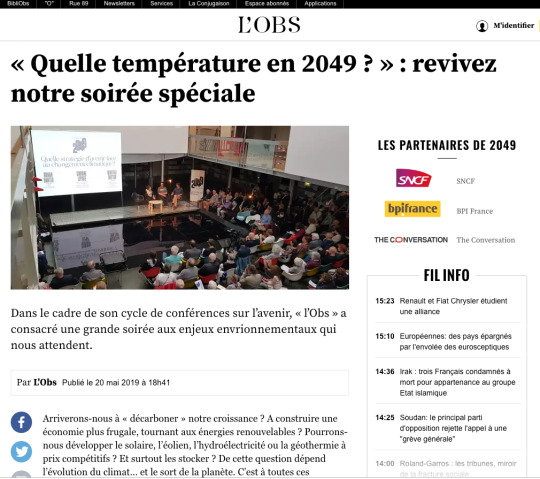
« Quelle température en 2049 ? » : revivez notre soirée spéciale
Dans le cadre de son cycle de conférences sur l’avenir, « l’Obs » a consacré une grande soirée aux enjeux envrionnementaux qui nous attendent.
Par L'Obs
Publié le
20 mai 2019 à 18h41
Arriverons-nous à « décarboner » notre croissance ? A construire une économie plus frugale, tournant aux énergies renouvelables ? Pourrons-nous développer le solaire, l’éolien, l’hydroélectricité ou la géothermie à prix compétitifs ? Et surtout les stocker ? De cette question dépend l’évolution du climat... et le sort de la planète. C’est à toutes ces questions que « l’Obs » a consacré une soirée entière lundi 20 mai lors d’une soirée-rencontre au Pavillon de l’Arsenal (Paris IV).

« Quel menu en 2049 ? » : inscrivez-vous à la rencontre de Dijon le 13 juin
Qu’y aura-t-il dans nos assiettes en 2049 ? Venez en discuter avec nous le 13 juin prochain.
Par L'Obs
Publié le
21 mai 2019 à 18h51
Si le monde entier se met à manger comme les Occidentaux, nous subirons rapidement une pénurie de protéines animales. Quel système agricole développer afin de produire assez pour tout le monde, sans pour autant épuiser les ressources de la terre ? Protéines d’insecte et protéines végétales viendront-elles se substituer aux protéines animales ? Sera-t-on capable de faire « pousser » de la viande cellulaire artificielle ? C’est à toutes ces questions que nous répondrons avec nos idées lors de notre prochaine soirée « 2049 ».
Inscrivez-vous à cette soirée-rencontre le 13 juin prochain à Dijon (entrée gratuite sur inscription). Plus d’infos à venir.
0 notes
Photo

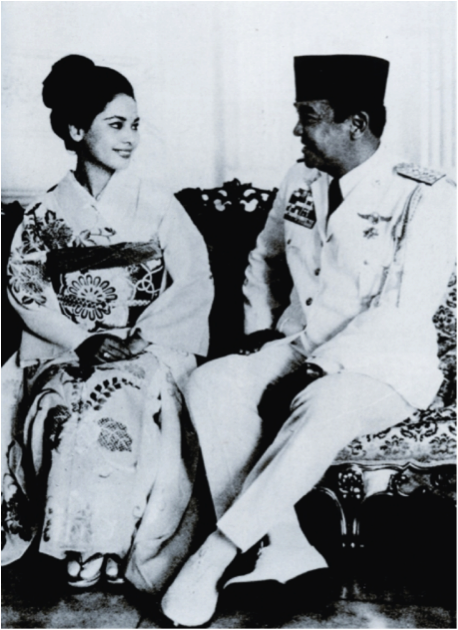
(via From Bandung to Berlin)



0 notes
Link

Il semble toujours difficile de saisir une enquête sociologique, car, comme toute bonne enquête sociologique, celles-ci sont surtout qualitatives et se fondent sur des témoignages peu nombreux et variés… dont il semble difficile de dégager des lignes directrices. C’est pourtant ce que réussit à faire la sociologue Dominique Pasquier dans son livre, L’internet des familles modestes en s’intéressant aux transformations des univers populaires par le prisme des usages et des pratiques d’internet.
Alors qu’il n’y a pas si longtemps, la fracture numérique semblait ne pouvoir se résorber, les usagers les plus modestes semblent finalement avoir adopté les outils numériques très rapidement, à l’image de l’introduction de la photographie au début du XXe siècle dans les sociétés rurales traditionnelles qu’évoquait Pierre Bourdieu dans Un art moyen. L’internet des classes dominantes et urbaines a colonisé la société, rapporte Dominique Pasquier dans son étude où elle s’est intéressée aux employées (majoritairement des femmes) travaillant principalement dans le secteur des services à la personne et vivant dans des zones rurales. En matière de temps, d’utilisation des services en lignes, les usages d’internet des plus modestes ont rejoint les taux d’usages des classes supérieures. Reste à savoir si les usages sont les mêmes du haut au bas de l’échelle sociale. Interview.
1 note
·
View note


